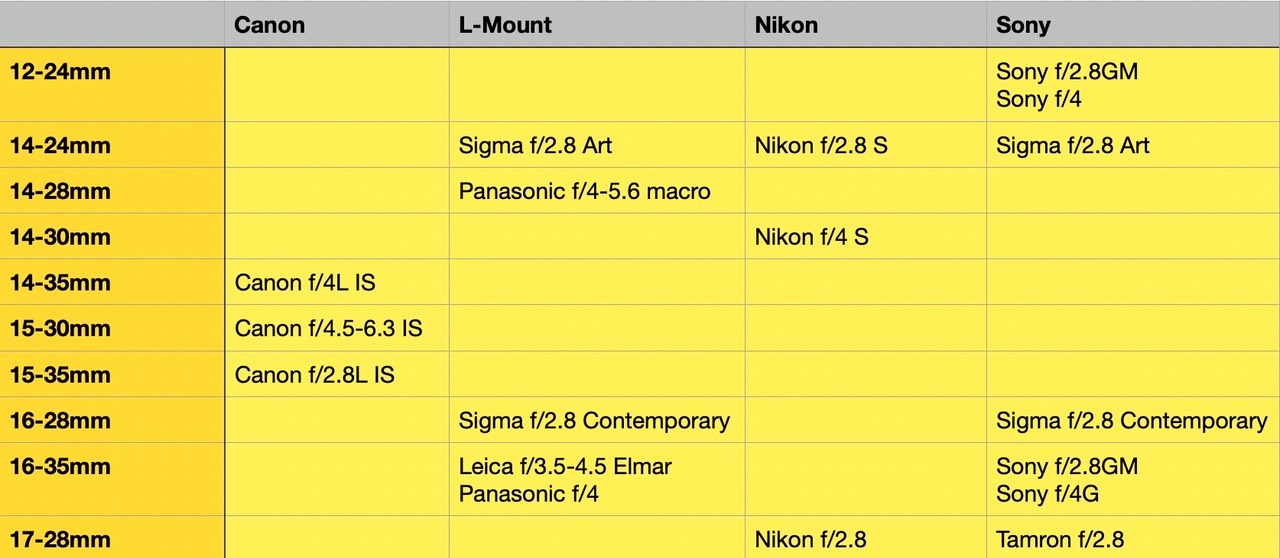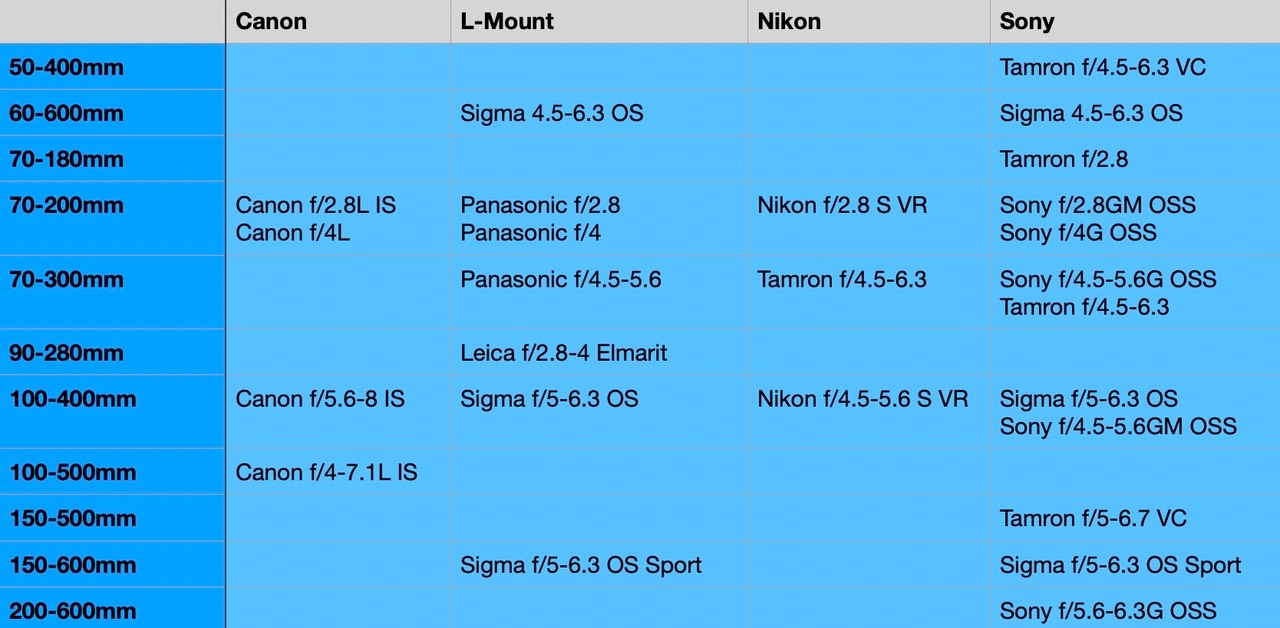Back in December of last year I posted an article where I disguised what I believed was Nikon’s actual third-party lens strategy in a “three options” conspiracy theory list (you’ll note that the third option had a lot more meat to it than the others, partially giving away what I was really writing about). I wrote the article the way I did for several reasons, one of which was to see if I could prod Nikon to come clean and acknowledge what might be going on.
I had three sources for that third theory: one from a lens maker outside of Nikon, one from inside Nikon, and one in an anonymous email. When I originally heard from the lens maker, I didn’t entirely believe what they were telling me. But a casual statement from someone at Nikon coupled with the anonymous tip triggered my article.
Now that Nikon Rumors has gone further and published an article stating that theory #3 is likely the strategy Nikon is pursuing, it’s time to talk about what this might mean in terms of future lenses. Before we get started, note that the theory is still not acknowledged or verified. I do believe the evidence is slowly stacking up that limited licensing is what Nikon is doing with the Z-mount, though.
So here’s what that alleged policy looks like in a shortened version: Nikon will license the Z-mount to third-party makers (including all mount communications) only to companies that use that information to create non-competing lenses. Non-competing seems to mean "not the same focal length(s) and aperture(s).”
Sony’s mount licensing policy has no such restriction that I know of. Canon apparently is not licensing their mount at all. So Nikon’s supposed policy straddles what their other two main competitors are doing.
I’m just going to look at what that policy might mean for zoom lenses for the moment, since that’s where the bulk of the lens buying is currently done.
Let’s start with wide angle zooms. Here’s the current situation for full frame:

Nikon licensed Tamron’s 17-28mm f/2.8 to put in the Nikkor lineup directly. That leaves only two possible third party zooms of interest:
- Sigma 14-24mm f/2.8 — This lens would directly compete with a Nikkor specification, and thus wouldn’t be licensed under a non-compete policy.
- Sigma 16-28mm f/2.8 — Technically, the extra millimeter at the wide end changes the specification, but I’d bet that Nikon would still call that competitive with the 17-28mm f/2.8.
A paucity of wide angle zooms exist in the first place in all full frame mirrorless mounts, and Nikon’s alleged policy wouldn’t currently expand the Z-mount offerings.
Next, I’ll tackle the mid-range zooms:
Here, there’s been more activity and an additional player (Samyang). That said, you’ll see that there aren’t a lot of options that might come to fruition in the Z-mount under Nikon’s supposed policy:
- Samyang and Sigma 24-70mm f/2.8 — These are duplicative of a Nikkor, so wouldn’t be allowed.
- Sigma 28-70mm f/2.8 — As before, a minor change in one focal length probably isn’t enough to pass the “same spec” inspection.
- Tamron 28-75mm f/2.8 G2 — The G1 version of this lens has already been licensed by Nikon; what I call a Tamrikon lens (half the letters come from Tamron, half from Nikon). It seems unlikely that we’ll see a G2 version any time soon, and even then it probably would end up in Nikkor cladding.
- Tamron 28-200mm f/2.8-5.6 — Nikon has a 24-200mm, but it’s not as fast at the wide end, and the difference in angle of view between 24mm and 28mm is very significant. I believe that Nikon would probably allow this lens to be made by Tamron in the Z-mount. The question then becomes does Tamron see a benefit in doing so?
- Tamron 35-150mm f/2-2.8 — Probably the most desired of the possibilities. One source keeps trying to tell me that it’s destined for Tamrikonification. I’m not sure whether or not to believe them. But whether in Tamron or Nikkor name, this is the first of the possible current zoom lenses that be highly welcome in the Z-mount for reasons other than “I want a cheaper option from a third-party.” This lens would be a welcome addition to the Z-mount, for sure.
Which brings us to telephoto zooms:

Again, a lot of options have appeared in the market, and, of course, we have a Tamrikon 70-180mm f/2.8 and a Nikkor 200-600mm f/5-6.3 (likely) on the Nikon Road Map coming this year. Let’s look at the possibilities:
- Tamron 50-400mm f/4.5-6.3 — Possibly enough different from the 100-400mm to pass Nikon’s spec inspection. It’s wider at the one end, providing something useful, and it’s slower at the telephoto end.
- Sigma 60-600mm f/4.5-6.3 — I see a lot of requests for this in the Z-mount. Is the 60mm end enough to get past Nikon’s spec inspection? Well, if the Tamron above does, so would the Sigma, I would argue. But I’d bet this lens would give a lot of grief to Nikon’s 200-600mm sales, so it might not pass spec inspection.
- Tamron 70-180mm f/2.8 — Already announced as coming in Tamrikon form.
- Tamron 70-300mm f/4.5-6.3 — Already shipping from Tamron in the Z-mount, which would seem to indicate that Nikon itself isn’t planning a similar 70-300mm lens. The Tamron doesn’t have image stabilization, so if Nikon did eventually produce a 70-300mm, I’d bet it would have VR.
- Sigma 100-400mm f/5-6.3 — Is the fact that this lens is slower than the Nikkor enough for Nikon to say “okay”? As with the 60-600mm, letting this lens exist in the Z-mount would directly hurt a Nikon lenses' sales.
- Tamron 150-500mm f/5-6.7 — As you can probably see, we’re getting a lot of similar-but-not-quite-the-same specifications in the telephoto zoom range. I suspect that this lens might be just enough distinguished from the upcoming 200-600mm to get a pass. It sort of slots between 100-400mm and 200-600mm, doesn’t it?
- Sigma 150-600mm f/5-6.3 — But does adding 100mm at the long end and dropping the aperture spec a bit (compared to the Tamron in the previous bullet) change the equation? Suddenly the upcoming 200-600mm f/5-6.3 would have fairly direct competitor. I don’t think Nikon would approve this lens under their alleged mount licensing policy.
Which brings us to another thing: we’re basically talking about two lens makers when it comes to third-party full frame zooms these days: Sigma and Tamron. It seems clear that Tamron has already bought into Nikon’s demands (whatever they might have actually been) and found a place where they can both OEM a few of their lenses that fill in slots that Nikon wasn’t (lower cost f/2.8 zooms, some focal length ranges not in Nikon’s plans), while still providing their other lenses (e.g. the 70-300mm) under the Tamron name. So I believe we’ll eventually see much of the Tamron lineup in either Tamrikon or Tamron guise.
It’s Sigma that’s the issue. While I’ve only described the zooms here, the situation with primes is worse as there’s the question of whether f/1.4 is enough distinguished from f/1.2 or f/1.8 to pass the spec inspection. It’s been hinted at by others that Sigma has been balking at Nikon’s demands. You can sort of see why in just the zoom lists, above: the current Sigmas are stepping right on Nikkor lenses for the most part. By authorizing them, Nikon would essentially create a direct competitor in each case to a Nikkor offering, many at lower cost to the consumer.
Personally, I don’t believe in playing anti-competition games. Why? Because they don’t put pressure on you to get better, they slow down your own development while everything has to go through competitive negotiations, and they eventually don’t work. Basically, anti-competition is a stall tactic, and I hate stall tactics in high tech. Stall tactics make you less competitive over time. Meanwhile, tech keeps moving at rapid speed, so you fall behind.
Nikon’s supposed mount licensing scheme is anti-competitive at its core. While it might have short-term gains for Nikon as it forces their legacy users to “buy Nikon,” NIkon will also lose legacy users over time as customers become aware of such a licensing strategy. Whether true or not in practice, the expectation of open competition in the lens game is that more options become available, not less. Who doesn’t want more options for their “system camera?”
Nikon appears to have tipped their hand with statements made alongside their quarterly financial disclosures. Nikon executives are on record saying that they have a goal of achieving a 2x lens attachment rate (i.e. two lenses sold for every body). Currently, it’s at 1.79x, and that’s up from their DSLR norm of 1.5-1.6x. To get a higher attachment rate, Nikon needs lots of lens choices (thus the Tamrikons), but fewer competitors.
All that said, here’s what I see when I look at the zoom lens charts: the mid-range and telephoto options in the Z-mount are already looking pretty good, and should fill in even better within the next year. Wide angle is where I see a weakness, but that weakness wouldn’t currently be helped by any existing Sigma and Tamron offerings: there’s just a general gap to what Canon and Sony are doing in that category that isn’t filled via third-parties. Nikon needs a wider 12-24mm type lens, and it needs a fast 16-35mm type lens at a minimum. We’re also starting to see bridge lenses that go from wide angle to mid-range (e.g. 20-40mm, 20-70mm), which Nikon hasn’t yet explored.
I also need to point out Nikon hasn’t put out a dud Z-mount zoom lens yet. The 24-50mm f/3.5-6.3 is arguably the weakest performing zoom, but it’s there for a reason other than optical excellence. With the class-leading excellence of the S-line zooms, I simply don’t understand why Nikon would be so worried about competition. The problem Nikon is apparently overlooking is that any perception of less lens availability will hurt body sales.
Make the best product. Keep making it better. Get to dominating excellence before the competition. Make sure you market those attributes well. That would be my strategy for anything, including lenses.
